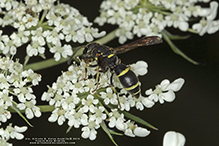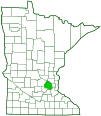republic mason wasp
(Leptochilus republicanus)
Conservation • Description • Habitat • Ecology • Distribution • Taxonomy
Conservation Status |
|
|||||||
| IUCN Red List | not listed |
|||||||
| NatureServe | not listed |
|||||||
| Minnesota | not listed |
|||||||
Description |
||
Republic mason wasp is a small stinging wasp. It occurs in the United States from the East Coast to the Great Plains. Adults in the north are black with yellow markings, while those in the south also have red markings. The front part of the body (mesosoma) is connected to the rear part (metasoma) by a narrow waist. Wasp size is often given in terms of the length of the forewing, which in this case is 3⁄16″ to ¼″ (5.5 to 6.5 mm). On the female the head is black. There are two large compound eyes, one on each side of the head, and three small simple eyes (ocelli) in a triangular pattern at the top of the head between the compound eyes. The inner margin of each compound eye is deeply notched. The area between the ocelli is flat, not a rounded bump (tuberculate). The antennae are thread-like and have 12 segments, including a long first segment (scape) at the base, a short second segment (pedicel), and a whip-like section (flagellum) with 10 segments (flagellomeres). They are entirely black. The first flagellomere is about as long as the second. The last flagellomere is not hooked at the tip. The area between the antennae bases is flat, not produced outward and pointed. The plate on the face (clypeus) is strongly convex on the lower margin. It is black with a yellow spot on the upper margin that varies from very small to covering the upper half of the clypeus. The mouthparts are very long. When extended they reach to the base of the middle pair of legs. The jaws (mandibles) are long and knife-like. The thorax is black and has three segments, the prothorax, mesothorax, and metathorax. However, the first segment of the abdomen (propodeum) is fused to the thorax, giving the thorax the appearance of having four segments. The upper plate on the prothorax (pronotum) is short and collar-like. It has a narrow transverse ridge (carina) on the front margin. It extends rearward on the sides to the plate at the base of each wing (tegula). It appears horseshoe-shaped when viewed from above, triangular when viewed from the side. It is mostly black except for a yellow band on the front margin of the upper surface. The band tapers narrowly to each side, narrows toward the middle, and is interrupted in the middle. The rear face of the pronotum does not have a pair of pits in the middle. On the mesothorax, the large front plate (mesoscutum or scutum) is black with no yellow markings. The smaller rear plate (scutellum) has a pair of rectangular, narrowly separated, yellow spots. The upper surface of the metathorax (metanotum) is entirely black, with no yellow markings. The propodeum has a very prominent transverse ridge (submarginal carina). The valve on the propodeum (propodeal valvula) is free from the submarginal carina (not fused to it) on the upper, lower, and rear margins. There is a small yellow spot at the base of each forewing and a larger yellow spot on the side of the thorax below the wing bases. The upper part of the first segment of the metasoma (first tergite) is wider than long and only half as long as the second tergite. It is black with a yellow band at the rear. It does not have a transverse carina. The second tergite has a broad yellow band at the rear and is almost as long as the remaining tergites combined. There is usually a well-developed band at the rear of the third segment, but this is sometimes missing. The wings are tinted smoky brown and have dark veins. There are three submarginal cells. At the base of the second submarginal cell the media (M) vein has two distinct kinks. On the male each antenna has 13 segments. The flagellum is hooked at the tip. The underside of the scape is yellow. The clypeus is entirely yellow. The third segment (femur) of the middle legs does not have a broad depression on the underside at the base. |
||
Size |
||
Forewing length: 3⁄16″ to ¼″ (5.5 to 6.5 mm) |
||
Similar Species |
||
Habitat |
||
|
||
Ecology |
||
Season |
||
|
||
Behavior |
||
|
||
Life Cycle |
||
|
||
Larva Food |
||
|
||
Adult Food |
||
|
||
Distribution |
||||
|
Sources |
|||
| 4/30/2023 | ||||
Occurrence |
||||
|
||||
Taxonomy |
|||
Order |
Hymenoptera (ants, bees, wasps, and sawflies) | ||
Suborder |
Apocrita (narrow-waisted wasps, ants, and bees) | ||
| No Rank | Aculeata (ants, bees, and stinging wasps) | ||
Superfamily |
Vespoidea (vespoid wasps) | ||
Family |
Vespidae (hornets, paper wasps, potter wasps, and allies) | ||
Subfamily |
Eumeninae (potter and mason wasps) | ||
Genus |
Leptochilus | ||
Synonyms |
|||
|
|||
Common Names |
|||
republic mason wasp |
|||
Glossary
Clypeus
On insects, a hardened plate on the face above the upper lip (labrum).
Femur
On insects and arachnids, the third, largest, most robust segment of the leg, coming immediately before the tibia. On humans, the thigh bone.
Flagellomere
A segment of the whip-like third section of an insect antenna (flagellum).
Mesosoma
In Hymenoptera: the front part of the body, consisting of all three segments of the thorax and the first segment of the abdomen, to which the wings are attached.
Metasoma
In Hymenoptera: the armored rear part of the body, consisting of the second segment of the abdomen and all segments posterior to it.
Ocellus
Simple eye; an eye with a single lens. Plural: ocelli.
Pedicel
On plants: the stalk of a single flower in a cluster of flowers. On insects: the second segment of the antennae. On Hymenoptera and Araneae: the narrow stalk connecting the thorax to the abdomen: the preferred term is petiole.
Pronotum
The exoskeletal plate on the upper side of the first segment of the thorax of an insect.
Propodeum
In Hymenoptera: the last segment of the thorax, anatomically the first segment of the abdomen.
Scape
In plants: An erect, leafless stalk growing from the rootstock and supporting a flower or a flower cluster. In insects: The basal segment of the antenna.
Tegula
A small, hardened, plate, scale, or flap-like structure that overlaps the base of the forewing of insects in the orders Lepidoptera, Hymenoptera, Diptera, and Homoptera. Plural: tegulae.
Tergite
The upper (dorsal), hardened plate on a segment of the thorax or abdomen of an arthropod or myriapod.
Visitor Photos |
|||||
Share your photo of this insect. |
|||||
| This button not working for you? Simply email us at info@MinnesotaSeasons.com. Attach one or more photos and, if you like, a caption. |
|||||
Alfredo Colon |
|||||
 |
|||||
MinnesotaSeasons.com Photos |
|||||
|
|||||

Slideshows |
||

Visitor Videos |
|||
Share your video of this insect. |
|||
| This button not working for you? Simply email us at info@MinnesotaSeasons.com. Attach a video, a YouTube link, or a cloud storage link. |
|||
Other Videos |
|||

Created: 4/30/2023
Last Updated:


